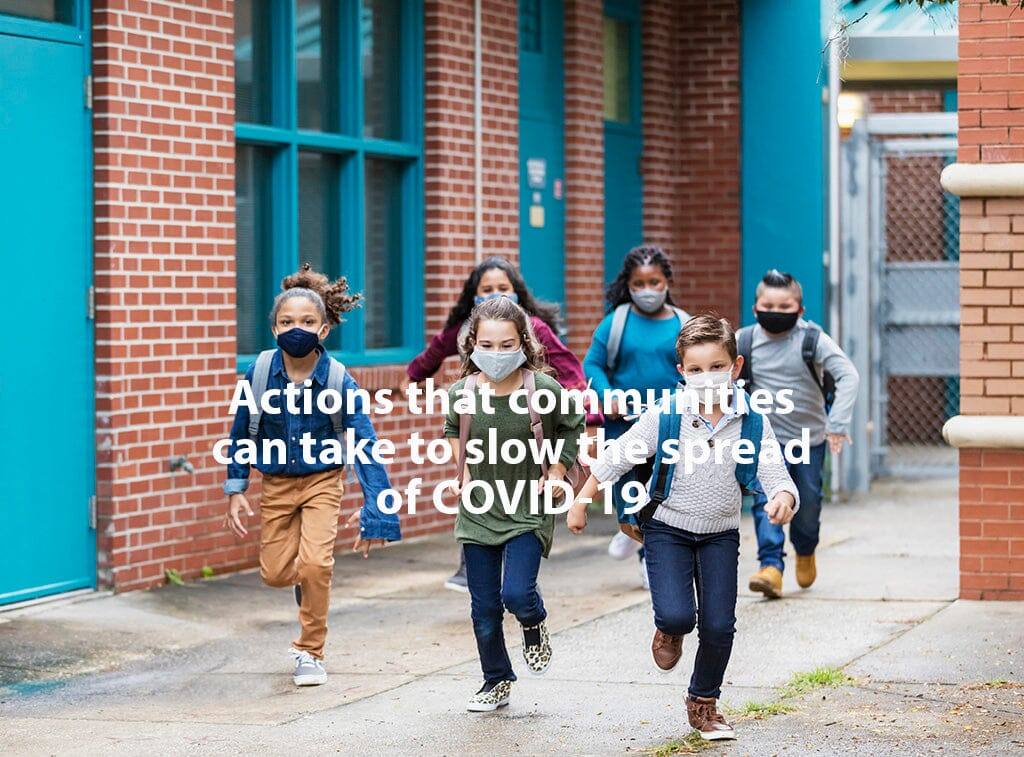
Actions that communities can take to slow the spread of COVID-19
Communities need schools because they provide safe, supportive learning environments for students, employ teachers and other staff, and make it possible for parents, guardians, and caregivers to work. With the pandemic, this entire sector converted to a virtual or hybrid model to ensure uninterrupted learning.
Essential elements for safe in-person learning and school operations:
The CDC develops several strategies that the K-12 school superintendent and decision-makers can implement to ensure the complete safety of the staff as well as the students. The strict adherence to these strategies can help in minimizing the spread of the COVID-19 virus, and schools can remain open for in-person instruction.
Some of these prevention and control components include:
- Proper implementation and adherence to layered prevention strategies to reduce virus transmission.
- Prevention strategies are implemented in phases based on the levels of community transmission.
- Identification of community risks based on the indicators.
The correct use of masks:
The correct and consistent use of masks is vital. All students and staff must use a well-fitting mask along with proper filtration to prevent the SARS-CoV-2 transmission through the respiratory particles and droplets.
Every person on the premises is advised to wear masks throughout the day to help prevent the spread of the virus. Exceptions can be made for certain settings and activities like sports. However, ensuring proper social distancing during these times is the key.
The best fabrics for cloth masks are those that are tightly woven, like cotton and cotton blends, which usually have at least two layers. Additionally, these masks make breathing easier. Whereas, masks with exhalation vents or openings, as well as fabrics made from loosely woven fibers or those that do not fit properly, should be avoided.
The use of masks on school buses as well as other public transportation should be mandated. School systems must also take the necessary steps to ensure compliance with this requirement by students, staff, and others.
The visitors to the schools should also be wearing masks at all times while maintaining physical distance from others. Additionally, local leaders and other respected members of the community could be encouraged to model the proper use of masks in the schools.
A majority portion of the students, including those with disabilities, could probably tolerate and safely wear a mask. However, a small subset of students with disabilities may not be able to wear a mask and thus could be more vulnerable to this deadly virus. So, the requirement to wear a mask should not apply to those who cannot wear one safely (like those with breathing difficulties). By following all the protocols strictly, this small subset of students can also be safe.
Suppose a child with a disability cannot maintain physical distance, wear a mask, or adhere to other public health requirements. In such a situation, too, the student has the right to receive an appropriate and proper education, which could, in some circumstances, be provided virtually.
The use of PPE in schools:

Personal protective equipment (PPE) contains a surgical mask, eye protection, disposable gloves, N95 respirator, and a gown (cloth or disposable). Schools are encouraged to implement a process for determining what kind of protective equipment must be worn by staff when working with students and under what circumstances. The choice of PPE for school staff members should be based on a number of factors, including:
- The type of service being provided like personal care, nursing treatments, etc.
- The risk of exposure that is anticipated in response to infectious body fluids and the individual health factors.
PPE should only be worn when needed, based on the support services that each student is receiving. PPE must be removed and properly disposed of safely, and hand washing should be completed prior to interacting or working with another teacher or student. It should be noted that cloth face coverings are not generally considered PPE.
Disposing and cleaning of PPE:
Used disposable PPE such as gloves, gowns, and masks can be disposed of in a lined garbage container and removed the same way as other school waste. Cleaning eye protection or face shields using a disinfectant should be done when visibly dirty or at least according to the manufacturer's direction.
The CDC recommends:
- While using gloves, carefully wipe the inside followed by the outside of the face shield with the help of a clean cloth soaked with any neutral detergent solution or even a cleaning wipe.
- Carefully wipe the outside of the face shield with a cloth saturated with EPA registered disinfectant solution.
- Wipe the outside of the face shield using clean water or even an alcohol wipe to remove residue.
- Dry fully by using air dry or use clean towels.
- Remove the gloves used and wash hands thoroughly. Gloves need to be changed after providing care to students, when dirty or contaminated, when ripped or torn, or when switching from a dirty to a clean procedure, like cleaning up vomit and then making medicine.
Vaccinations for staff and students:

Vaccinating teachers and staff is one brilliant way of adding a layer of protection and prevention for teachers and staff. Strategies that decrease barriers to access vaccination for teachers, as well as other essential workers like vaccine clinics at or close to the working areas, are optimal.
School officials, along with the health departments, can work together to enable support messaging or outreach about vaccination for members of school communities. It will be necessary to continue implementing layered prevention strategies until a better understanding of potential transmission among those who receive a COVID-19 vaccine is achieved and wider vaccine coverage among the general population is obtained.

Leave a comment